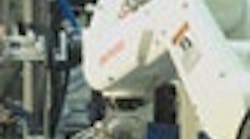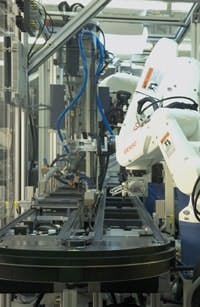Does this sound familiar? “We have a lot of old analog and pneumatic crap from the 1960s and ’70s; it’s severely aging, it has poor reliability, and much of it’s obsolete and unsupported,” says Dave Hooten, PE, electrical supervisor for instrumentation, control and design engineering at Progress Energy Carolinas in Raleigh, N.C. “We started trying to replace the worst offenders with digital equipment, but it was done willy-nilly and without an overall game plan, and so we ended up with different single-loop controllers for our moisture separator reheater (MSR) drain levels, different digital feed-water controllers, several digital recorders and other one-point solutions, as well as different loose parts. They all operated differently and didn’t communicate with each other, so we began to see the need to standardize.”
Jim Montague is the executive editor for Control. Email him at jmontague@endeavorb2b.com.
Progress Energy runs five nuclear power plants, as well as coal, gas/oil and hydropower applications that collectively generate 21,000 MW and serve 3.1 million customers in North Carolina, South Carolina and Florida. The utility recently secured a 20-year license renewal for its oldest nuclear plant in Hartsville, S.C., which was built in 1970, and is seeking renewals for two more in Southport, N.C. However, to operate efficiently in future decades, the plants needed standardized digital components and a unified digital network, says Hooten. In 2003, the plants formed a team to evaluate 12 distributed control systems (DCSs), and sought bids on three.
“We stopped and asked ourselves what we were doing here,” says Hooten. “We found that 70% of our non-safety-related instrumentation and controls (I&C) could be on a DCS and a digital network. We wanted to pick one solution for all four sites and have a more strategic alliance with its vendor because our biggest criteria was that, unlike a fossil-fuel application, we couldn’t shut everything down and rip and replace. We would have to do our upgrade in pieces. We also needed good forward and backward compatibility, so we could have scalability and high confidence in our DCS in the long run.”
Hooten says they were nervous, and the project was hard to do. “However, I believed if we could just do one successful upgrade, then it would sell itself,” he adds. “In fact, we just finished our first project a few weeks ago at Harris 1 (Figure 1) in New Hill, N.C., and the guys already are asking, ‘When are we doing the next one?’ Every senior manager we’ve shown this to is giddy.”
Nuclear Network
Progress Energy’s Harris 1 nuclear plant replaced analog and pneumatic hardwiring in its three-level reactor auxiliary building’s supply and exhaust fan system with a DCS, digital network and Ethernet, as well as HART transmitters.
Source: Progress Energy
Precipitating Events
Unfortunately, until a better way arrives, the old “if it’s not broke, don’t fix it” mantra still holds. So, even though many devices will likely bust and fail soon, and despite all the hype and node growth surrounding fieldbuses, Ethernet and now wireless, it’s still no surprise to find that a significant majority of all installed control and automation systems still rely on point-to-point hardwiring.
Helge Hornis, Ph.D., intelligent systems manager at Pepperl+Fuchs (P+F) explains, “The engineering staffs at many manufacturers are stretched thin, and so many are doing the same thing they’ve done for the past 10 years. They don’t feel like they have the time to reinvent to make better solutions. But they’ve got to break out of that mode or they’re going to go under. However, it takes management with vision and guts to try new things. As a result, a lot of innovation comes from newer companies that don’t have the baggage of old PLC code and design drawings.” Consequently, it’s during these brief, often unplanned downtimes that many end users find they must finally move from hardwired, point-to-point networks to twisted-pair fieldbuses, Ethernet or other digital networks, often for the first time.
“About 90% of the applications we see still have hardwired field devices because users don’t want to put them on a digital network or Ethernet,” says Dave Blaida, of Matrix Technologies, a CSIA-certified system integrator in Maumee, Ohio. “However, the line between 4-20 mA field networks and data networks are blurring as SCADA and HMI application get more data-intensive. More clients are considering using them, even though they might have had no data network before. We quoted a couple of chemical processing projects recently that included wiring a valve to an I/O point by using actuator-sensor interface (AS-i) bus to replace the hardwiring back to that valve. So, rather than wire each valve back to a PLC, a bank pre-wired with AS-i can send all the valves’ I/O data back through one cable to the PLC. This can save 75% on traditional hardwiring costs.”
Tom Lycans, Matrix’s senior engineer, adds that doing this requires users to make a mental shift from checking I/O performance, wire by wire, to verifying each point via the digital network and a PLC program software display. “You still need to check each valve when you install them, but now you can see limit switch indications on variables such as 50% open on the network,” explains Lycans.
Healthy Skepticism, Hidden Costs
Whether it’s triggered by a breakdown, scarce spare parts or another event, the decision to implement a first digital network usually focuses on whether the user’s application is approaching, has reached or has gone over the tipping point between the expense of maintaining its hardwiring and the cost of a new digital network.
“If you’re putting in 500 new valves, you have a lot of options about how to talk to them. However, if you have a lot of legacy hardware installed, then your only real choices are to leave them alone or replace a bunch of them,” explains Hunter Vegas, of Avid Solutions (avidsolutionsinc.com), a system integrator in Winston-Salem, N.C. “Still, if you have standalone PLCs hardwired to valves and you want to see and control them, then you can add remote I/O equipment, move the hardwired valves to the remote I/O or leave the field devices alone and replace the interface to them. Our typical retrofits now involve removing old PLCs and HMIs and adding new equipment with more automation in several phases.”
Vegas adds it’s crucial for end users to evaluate which digital networks are available, to learn their true pros and cons and to seek help to determine which is best for their applications. He says this is especially important because many digital networks and fieldbus protocols promise more than they deliver on the plant floor, and so their costs increase when users have to add more equipment to make up for performance lags.
“Many fieldbuses claim they can handle 1,000 devices on one wire, but they really can only handle 8-10, once you take into account voltage drops, cable lengths, communication times and other issues. And, if intrinsic safety is involved, they may only handle four or five nodes,” adds Vegas. “These are the physical limits and nitty-gritty ‘gotchas’ that most users don’t consider until they’ve been whumped. And these limits generate hidden costs of fieldbuses, which users need to know about before deciding if a digital network is worth doing. Meanwhile, a 4-20 mA wire just runs from here to there, and so it may be better to continue using it in a lot of cases.”
Think Ahead, Start Small
Perhaps the most important part of moving from hardwiring to digital networking is planning ahead, rather than simply stringing one more wire.
“Digital networks just require a lot more forethought when you’re designing them,” explains Lycans. “You have to understand the installation requirements, follow manufacturers’ guidelines and consider cable lengths, drop lengths between devices and how many devices can be on that network. Whether it’s AS-i, DeviceNet, Profibus, Foundation fieldbus or EthetNet/IP, each protocol has its own physical and software requirements, and they still don’t interoperate at the device level. There are adapter cards that allow higher-level communications, but they still have different electrical characteristics at the lower levels.”
Vegas suggests users start small when migrating to a digital network. “Doing a self-contained, small-potatoes capital job will let you dip your toe in before jumping in completely,” he says. “For example, at Cytec Industries’ chemical batch plant in Connecticut, we’re helping to swap 1,200 loops. However, these conversions started small by moving 15-20 I/O points to AS-i, so we could learn all the good, bad and ugly characteristics of each application and get comfortable with switching to a digital network before putting it in four plants.”
Tester Testing
Automation Engineering’s automated assembly and test systems (AATSs) use DeviceNet, ControlNet, Profibus and Ethernet and remote I/O methods to produce window regulator switches for cars.
Source: Automation Engineering
Deploy Digital, Gain Control
Sometimes a new network involves shifting from monitoring to real-time control. For instance, Automation Engineering in Fort Wayne, Ind., used analog hardwiring and serial communications between its I/O devices and controllers for 20 years but then began using ControlNet, and Ethernet about five years ago for communications and programming on its automated assembly and test systems (AATSs) (Figure 2). These include its new 37-ft window regulator switch (WRS) AATS that’s now in development. It has five HMIs, one large PLC, eight Denso robots, two Keyence vision systems, two computers, and more than 800 inputs and outputs.
“We needed to save on wiring, so last year we jumped on board using digital networking and remote I/O for control,” says Mike Jansen, Automation Engineering’s technology vice president. “All of WRS’s components are tied together by Ethernet, so we can plug in and program it anywhere. We knew the controls had to go over a digital network, but instead of using hardwired I/O points, we decided to implement remote I/O blocks close to the robots, vision systems and sensors they control.”
WRS now has three DeviceNet networks, including one for I/O points, another to control the robots and a third that works with 30 RFID readers and writers to track parts on the machine’s conveyor. “There’s a big difference for us between operating 64 devices on I/O blocks and running 64 cables back to a hardwired PLC rack versus running one DeviceNet cable from the PLC to an I/O block,” adds Jansen. “It’s simpler for us to build, and easier for our Tier 1 automotive clients to use and troubleshoot. When a device fails, the digital network shows its presence immediately. Knowing it’s time to replace a cable is pretty useful on robots that make 1.8 million moves per year.”
A Leapfrog to Ethernet
Logically, if a digital network on one machine or application is good, deploying it in many facilities will be better. John Canary, electrical supervisor at Rexam Beverage Can North America in Elk Grove Village, Ill., says implementing digital networks and Ethernet in its can-making machines helps his staff maintain production systems at about 30 plants in North America, each with two to six production lines.
“We used to fly everywhere to service the Siemens’ Peerlink systems we’d been using for 20 years,” says Canary. “So, for the past five years, we’ve been trying to get live, remote access to all our PLCs to help us manage our time better and make up for some of our retired engineers.”
Rexam’s own tipping point came when it could no longer find rebuilt cards for the Peerlink equipment in its racks of TI 505 PLCs. Depending on the particular plant, the firm’s can-making machines have used point-to-point Data Highway Plus (DH+), Modbus Plus and Profibus since the 1990s, according to Chad Valien, Rexam’s electrical process engineer.
“So, in 2007, we began gutting the four lines in our plant in Whitehouse, Ohio, and shipped the machines here to be upgraded with new PLCs and Hirschmann managed Ethernet switches,” explains Valien. “Then we sent them back and reinstalled these entire lines. These new controls are easier to reprogram, which lets us make more can sizes more easily, which our customers have been demanding in the past few years.”
Better, Easier Tools
Another factor in deciding whether to undertake a first digital network is that tools for doing it are getting easier to use. Programming, configuring and maintaining software for digital network switches are more point-and-click, and less writing software code, lately. Also, network sniffers and data packet analyzers can more easily calculate segment loads and check network traffic settings.
For example, Möllers North America in Grand Rapids, Mich., recently added AS-i and some P+F devices to one of the new stretch hooders it’s building. Rather than spinning and wrapping a pallet, stretch hooders pull one formfitting piece of film over a loaded pallet, much like a shower cap over someone’s head.
“We typically use point-to-point wiring, but we’ve been checking out fieldbuses and found that we could eliminate trunk lines, increase our machine’s modularity and reduce labor and I/O points,” says Jonathan Van Sweden, Möllers’ electrical engineering supervisor. “We usually have about 100 field devices on this stretch hooder, and so our digital network will let us cut our field connections by two-thirds from about 500 to 200. AS-i is just a natural fit for us because it doesn’t require lot of extra time or work to plan and program it.”
Real Benefits, Serious Savings
Similarly, back at Progress Energy, Hooten explains that Honeywell Process Solutions’ Experion PKS DCS was first implemented in the normal ventilation controls at Harris 1’s three-level, radiological-controlled reactor auxiliary building, where it controls six exhaust fans and two supply fans. This installation also included fault-tolerant Ethernet TCP/IP networking, eight or nine HART-enabled smart transmitters to relay exhaust flow data and about 100 total I/O points. Three or four more upgrades are planned, which include adding Experion PKS to Harris 1’s entire radiation monitoring system, incorporating it during replacement of the plant’s main turbine control system and integrating it with the plant’s ATWS mitigation system actuation circuitry (AMSAC) backup, which is used to protect the reactor. ATWS is defined as anticipated transient without scram.
“We used to have our plant’s computers do data acquisition, but Experion’s fault-tolerant Ethernet means our old guys now are learning to use Dell servers and Cisco edge-to-core switches, including their yellow and green (Ethernet) paths. With this architecture, if any route is broken, then there’s always a detour the communications can use,” says Hooten. “There was a lot of skepticism by folks who didn’t know how digital networks and Ethernet worked, and that initial ignorance led to some fear. So, before we started our project, we had our maintenance engineering and IT departments take a one-week Experion training course. It was at our site and based on our exact equipment, and that helped people accept it.”
Once its digital network and new DCS were installed, adds Hooten, they revealed problems that the former analog and pneumatic networks were masking. “We found stuck actuators that we didn’t know about because the former control signal didn’t test there,” he says. “We also found dampers that weren’t opening on our exhaust fans. In fact, a couple of dampers that were supposed to have an engineered range of 0-40,000 cfm exhaust flow only had 26,000 or 27,000.”
To users considering moving from hardwiring to digital, Hooten recommends not thinking of digital as a one-point solution. “It’s important to think of a digital network as an integrated solution that can help you achieve the goals you have for your application,” he says. “It’s time to take a longer and broader view. You have to think about where you and your instrumentation and controls want to be in 30 years and then manage your upgrades to help you get there.”
Our Square One Online Resources page has expanded coverage such as additional articles, videos, other digital network resources and an updated fieldbus comparison chart. Check this page now.
Convincing Management to MigrateBecause any capital project or expenditure requires managerial buy-in, digital network supporters must demonstrate that their proposed move from point-to-point hardwiring to a digital network, fieldbus or Ethernet will be a good investment. So, this plan must show that a digital network can:
|
Organizing for Digital AdoptionTo get co-workers and colleagues on board with a digital network evaluation and implementation project, advocates must follow several basic procedures.
|
Technical Design IssuesSeveral basic design and physical description parameters should be part of any thorough search for the right digital network for an application. These factors include but aren’t limited to:
|
Reasons to Go DigitalThere are many good reasons to implement your first digital network. Here are some of the most important:
So, it’s important to remember that digital networks generate far more savings than hardwiring over the long term in the form of easier, less-costly maintenance and troubleshooting and more useful, valuable data. |








